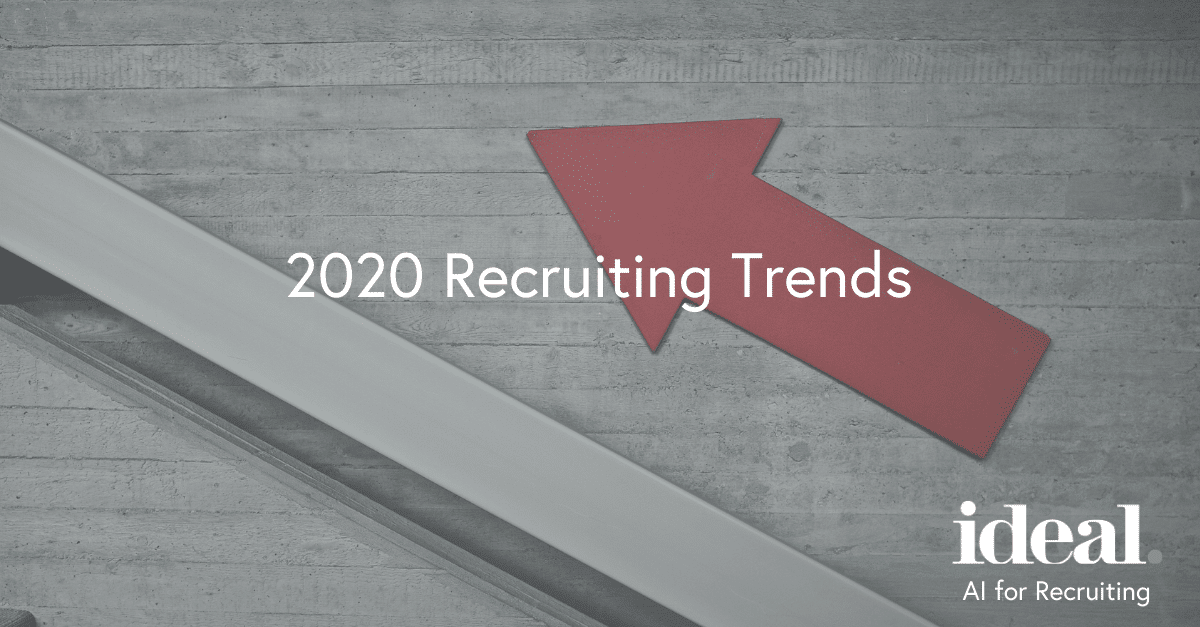We’re deep into Q4 2019 now, so it’s only natural that we start with the 2020 trends lists.
And it’s also true that for years, any recruiting / HR trends articles have focused largely on AI. AI for recruiting, per some statistics, is in about 24% of midsize to large organizations, with 56% planning to add it in the next year. At this point, then, AI is “here.” It’s not necessarily an emerging trend anymore; what’s emerging about AI is how companies are using it to maximize talent acquisition and speed/accuracy/long-term retention of their pipelines.
As a result, we’re not going to say “AI is a trend for 2020!,” even though AI for recruiting is the cornerstone of what we do. Beyond AI, though, what should recruiters be considering in the next 12-15 months?
Flexibility for candidates
Per an International Workplace Group survey, 80% of candidates would choose the offer (at least the appearance of) with more flexibility. That’s a big number, and this is a big advantage for recruiters. They need to find ways to offer flexibility in different situations: multiple young children (start/end times for work might need to be adjusted), aging parents (same, with more remote flexibility), and remote work in general. If your HQ is in Toronto but the best person for your team is in Denver and they can’t move right now, you should still find a way to bring them into the team. Don’t sacrifice candidate quality simply because of flexibility or location “needs.” We have enough technology — think about just Skype or Zoom — where these things can be managed successfully.
Will HR tech get more personalized?
Steve Boese, who manages the Las Vegas HR Tech conference, has pointed to this as a 2020 trend. The idea is that HR technology can sometimes feel very one-size-fits-all for the employees (or candidates in the case of recruiting). Can HR become more personalized? Boese uses the iPhone as an example. Every iPhone is shipped with the same apps pre-built and the same setup you need to follow. But if you lined up 100 new phone users, within minutes you’d have 100 different phones as they add the elements that are important to them. Employees should absolutely have the flexibility to customize how they interact with HR — it’s a little bit harder on the candidate side simply because you need specific information from a candidate, but candidate experience should always be a priority anyway.
Team-based or collaborative hiring
Some organizations are doing this and have been for close to a decade, but you’re starting to see it become more normative, which is good. According to a CareerBuilder study from the early 2010s, 88% of employers surveyed rated employee referrals higher than all other sources as the best means of generating return-on-investment. Recruiters and hiring managers are important stewards of a hiring process, but the members of the team that a candidate will join know best about the work that gets done, the pace of the year (busy seasons, etc.) and the personalities already on the team. As such, team-based hiring makes some sense. If you can set it up so that the hiring manager is still the “final vote,” i.e. not stripping them of any authority, it tends to work best.
Automation
This goes a little bit beyond AI. We mean intelligent automation of various, often-repetitive tasks throughout the HR workflow, be that recruiting or another functional area. The more you automate, the more you can free up people for value-add tasks. The more people are doing value-add tasks, the better your business runs — and chances are your turnover also reduces, because your employees will now find their work a bit more engaging and purposeful. So broad automation across the ecosystem can have a lot of benefits. The fear is always “This will kill jobs,” and yes, that might happen in some cases. But the bigger picture is that intelligent automation can continue to make existing jobs better by taking away the manual processes that tech can do better than humans anyway.
Importance of diversity
Diversity hasn’t been a great topic, especially in tech circles, over the last decade or so. We are seeing an increased commitment to diversity at some big organizations, and AI / machine learning advancements, thought by some to potentially limit diversity, are actually helping increase diversity in many places. There are still challenges in this area, for sure, but the bottom-line impact is there — more diverse companies have about 19% higher revenue.
The bottom line
Recruiting is constantly changing and evolving — and we have 4-5 generations currently who might actively be looking for jobs, so above all else, meet people where they are in their search and their career and try to find the best talent for your organization. These are some of the trends, but good candidate experience will never go out of style.
The post 2020 Recruiting Trends appeared first on Ideal.
